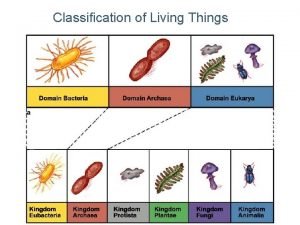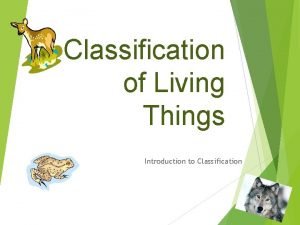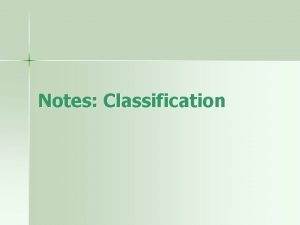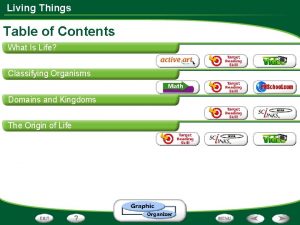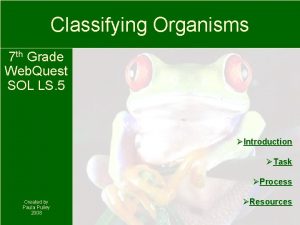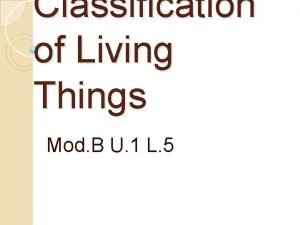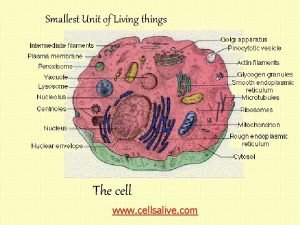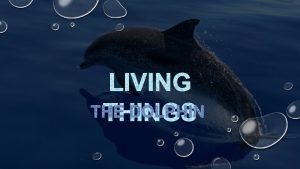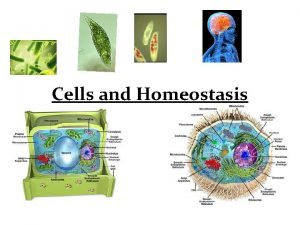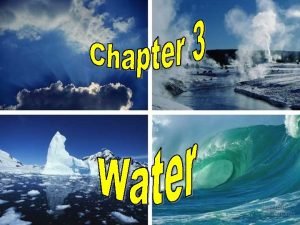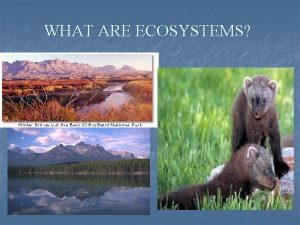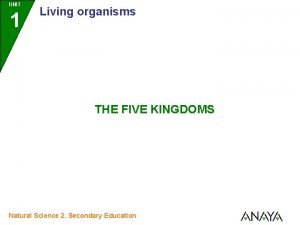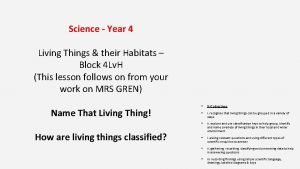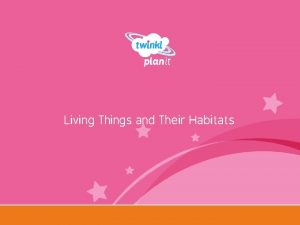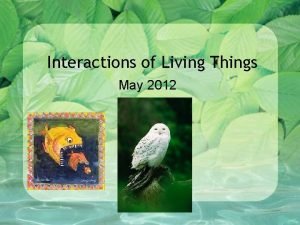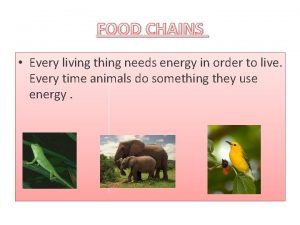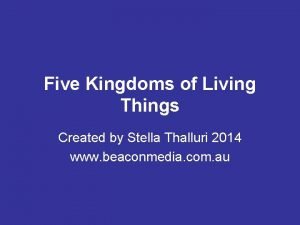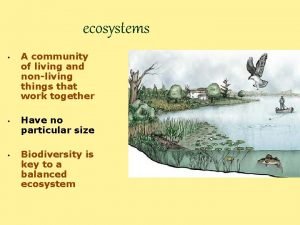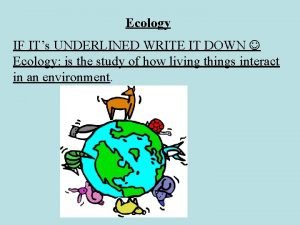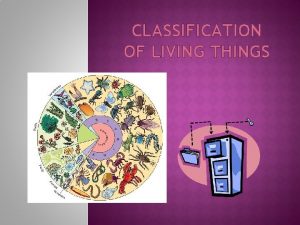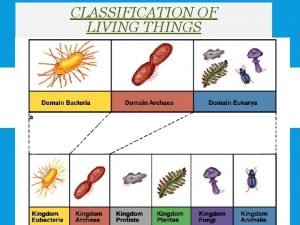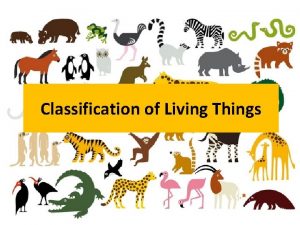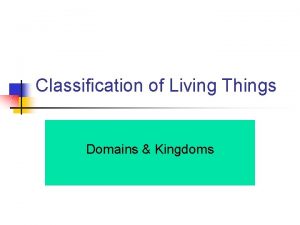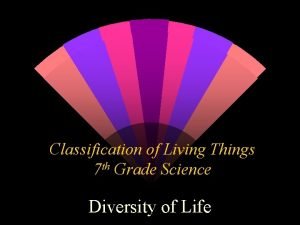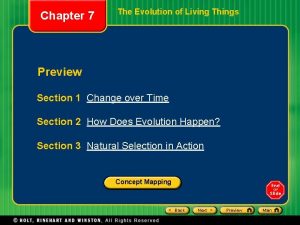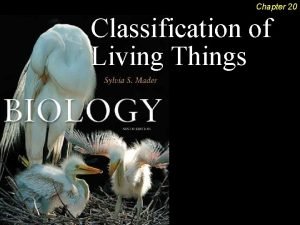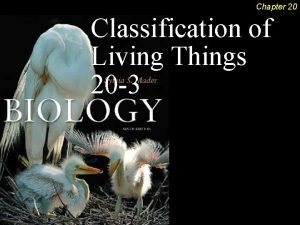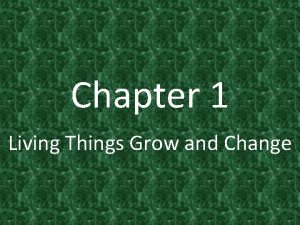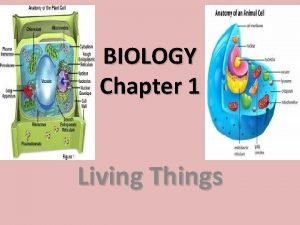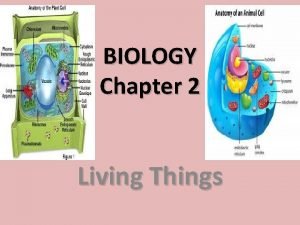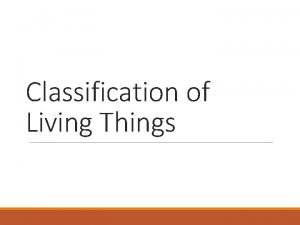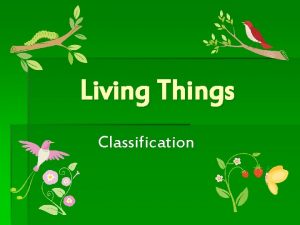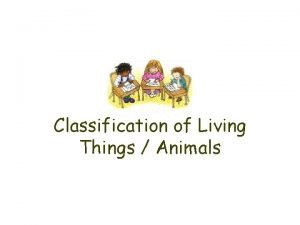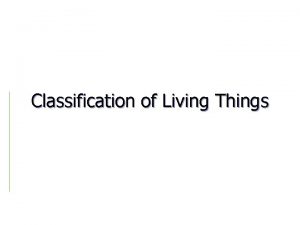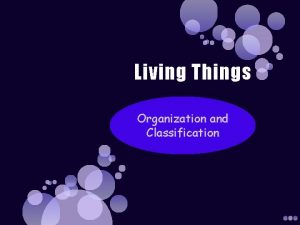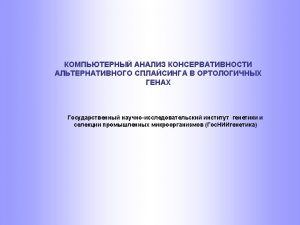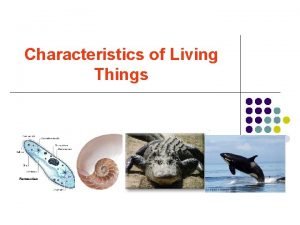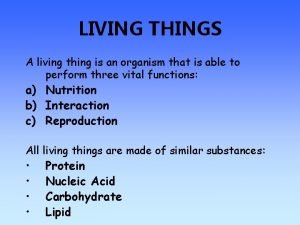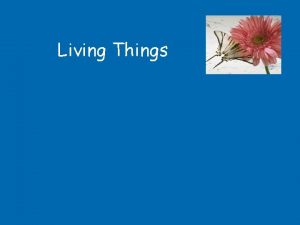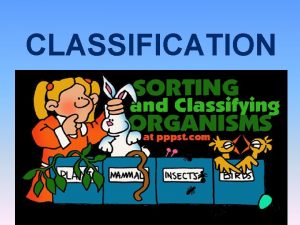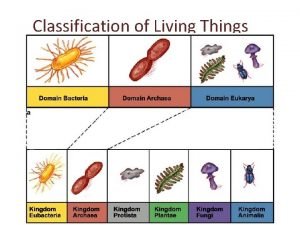Classification of living things Organism or Not Organism















































- Slides: 47

Classification of living things

Organism or Not Organism

What is an organism? An organism is a living thing. How do we know something is a living thing? With your partner, write down characteristics of living things.

Characteristics of Living Things 1. obtain and use resources 3. grow and develop growth development 2. reproduce 4. respond to stimulus

What do you think? 1. What is an organism? 2. How can you tell if something is an organism?

Water drop bacteria Chambered Nautilus paper clips fungus fire

living Chambered Nautilus Water drop nonliving paper clips bacteria living fungi nonliving fire living

All Living things must… 1. obtain and use resources for energy: • They must obtain (get) food, oxygen, and water to grow, develop and repair themselves.

Organisms are either: 1. Autotrophs= organisms that make their own food. For example plants. Or 2. Hetertrophs= organisms that do not make their own food. For example animals.

2. respond to stimuli: • A stimulus is any change in a living things environment. Some stimuli come from the enviroment, while some come from inside the organism. • A reaction to the stimulus is response. This is any action or behavior performed by the organism.

Match the stimulus and response: Stimulus: Bright light Loud sound Fear Hunger Change in temperature Response: Shed winter fur Close eyes Faster heart beat Hunt jump

3. reproduce Organisms produce offspring that have similar characteristics as the parent. There are two ways to reproduce: 1. Asexually - involves only one parent. The offspring are identical to the parent. 2. Sexually - involves two parents that produce offspring that have characteristics from each parent.

4. grow and develop Growth and development is not the same! Growth : When an organisms becomes larger. Development : When an organism becomes more complex structurally.

Growth or Development? You decide… 1. 2. 3. 4. 5. 6. An egg becoming a baby chick. A small plant becoming a larger plant. A tadpole to frog. A baby gaining five ounces in a week The baby learned to roll over The baby had longer hair in a year

Growth or Development? You decide… 1. 2. 3. 4. 5. 6. An egg becoming a baby chick. Development A small plant becoming a larger plant. Growth A tadpole to frog. Development A baby gaining five ounces in a week Growth The baby learned to roll over Development The baby had longer hair in a year Growth

Characteristics of Living Things Growth Development


What I Think • Divide these pictures into groups • Give each group a name and tell why you put the pictures together

Classification of Living Things 3. Classification is the process that scientists use to arrange organisms into groups based on the shared observable characteristics.

Classification of Living Things 4. Taxonomy is the science of identifying and classifying organisms into groups.

Characteristics of Living Things Continued from previous slide • A taxonomist is a scientist who identifies and names organisms based on their similarities and differences. • Taxonomist use physical characteristics as well as DNA, genetic information, to classify organisms.

Characteristics of Living Things 5. Scientist all over the world study organisms, in order to avoid confusion scientists need a universal way of naming organisms.

Characteristics of Living Things Mountain lion Cougar Puma Catamount Mountain Screamer and over 40 others Felis concolor

Characteristics of Living Things 6. A dichotomous key is a tool used to identify organisms. It uses a series of questions, each with only 2 answers.

Characteristics of Living Things 7. The scientific name is made up of the genus and species of the organism. The name is written in italics, the GENUS is capitalized, and the species is lower case; for example: the scientific name for a human is Homo sapiens because homo is our genus and sapiens is our species.

Characteristics of Living Things 8. The Linnaeus system is made up of seven levels, Kingdom, Phylum, Class, Order, Family, Genus, and Species. 1) King Philip Could Only Find Green Socks is one mnemonic way to remember the order of the levels. Another is King Philip Came Over For Good Spaghetti. 2) The levels are arranged from the most broad, Kingdom, to the most specific, Species.

Characteristics of Living Things 9. Kingdom- organisms are placed into kingdoms based on their ability to make food and the number of cells in their body.

Characteristics of Living Things 10. Phylum (phyla is plural)- In the Plant Kingdom, phyla are sometimes called divisions. In the Animal Kingdom, there are 35 different phyla.

Characteristics of Living Things 11. Class, Order, Family-these levels become even more specific. Each level has fewer organisms that have more in common with each other as you move down the levels.

Characteristics of Living Things 12. Genus- contains closely related organisms. The genus is the first word in an organism’s scientific name

Characteristics of Living Things 13. Species- consists of all the organisms of the same type which are able to breed and produce young of the same kind. The species is the second word in an organism’s scientific name.

Hybrid Species Only animals from the same species can produce offspring that are fertile. Liger

Hybrid Species Only animals from the same species can produce offspring that are fertile. Leopon

Hybrid Species Only animals from the same species can produce offspring that are fertile. Pumapar

Hybrid Species Only animals from the same species can produce offspring that are fertile. Zorse Zonkey

Hybrid Species Only animals from the same species can produce offspring that are fertile. Wolphins

Hybrid Species Only animals from the same species can produce offspring that are fertile. Cama

Hybrid Species Only animals from the same species can produce offspring that are fertile. Grolar

King Phillip Came Over For Good Spaghetti Kingdom Phylum Class Order Family Genus Species K P C O F G S Make your own mnemonic device


Characteristics of Living Things 14. Most scientists classify organisms into 5 kingdoms: Plants, Animals, Protists, Fungi, and Monera.

5 Kingdoms 14. Kingdoms 1) Plants (Plantae)- the plant kingdom is made up of plants. Plants are autotrophs, they make their own food. Plants are made up of many cells. Plants are divided into 2 groups: vascular and nonvascular.

5 Kingdoms 15. Kingdoms 2) Animals (Animalia)- the animal kingdom is made up of animals. Animals are heterotrophs- they must obtain food by eating it. Animals are made of many cells. The 35 phyla are divided into two groups: vertebrates and invertebrates.

5 Kingdoms 15. Kingdoms 3) Fungi- the fungi kingdom is made up of molds, yeasts, and mushrooms. Fungi are heterotrophs because they must absorb their food. Yeasts are one celled, while molds and yeasts are made of many cells.

5 Kingdoms 15. Kingdoms 4)Protists (Protista)- the protists are made up of organisms that cannot easily fit into the plant, animal, or fungi kingdoms. They are one celled organisms with a nucleus or simple multi-celled organisms.

5 Kingdoms 15. Kingdoms 5)Monera- the Monera kingdom is made up of bacteria. Their cells do not contain a nucleus. Some bacteria are autotrophs, some are heterotrophs.

Bacteria- New 6 Kingdoms organisms with no nucleus Archaea- single cell organisms with no nucleus that live in extreme conditions
 Venn diagram of living and non living things
Venn diagram of living and non living things What is the smallest living unit of life
What is the smallest living unit of life 7 things all living things do
7 things all living things do 8 levels of classification in order
8 levels of classification in order Living things classification
Living things classification Classification of living things quickchek
Classification of living things quickchek Thampis torrent frog
Thampis torrent frog Classification of living things notes
Classification of living things notes Domain of living things
Domain of living things Classification of living things webquest
Classification of living things webquest 8 levels of classification in order
8 levels of classification in order Why does organism eat another organism
Why does organism eat another organism Cell theory
Cell theory Dittulgia
Dittulgia Dolphin kingdom
Dolphin kingdom The smallest unit of living thing
The smallest unit of living thing Sadlier vocabulary workshop level d unit 1
Sadlier vocabulary workshop level d unit 1 Shell living or nonliving
Shell living or nonliving Living non living dead
Living non living dead Why is water important to living things
Why is water important to living things Non living things in grassland
Non living things in grassland What are the 5 kingdoms of living organisms
What are the 5 kingdoms of living organisms Life's structure and classification answers key
Life's structure and classification answers key Living things meaning
Living things meaning Ecosystems examples
Ecosystems examples Biomolecule
Biomolecule Jackal linnaean system
Jackal linnaean system The six kingdom
The six kingdom Living things 20
Living things 20 Everything that is alive needs energy
Everything that is alive needs energy Producer in a food chain
Producer in a food chain 5 kingdoms
5 kingdoms What is a community of living and nonliving things
What is a community of living and nonliving things Gets its energy from eating living things
Gets its energy from eating living things Kingdom archaea
Kingdom archaea Domain of living things
Domain of living things What are the 7 classifications of living things
What are the 7 classifications of living things 5 groups of living things
5 groups of living things Domain of living things
Domain of living things What are the 7 classifications of living things
What are the 7 classifications of living things How living things are organized
How living things are organized Structural adaptations examples
Structural adaptations examples Chapter 7 the evolution of living things answers
Chapter 7 the evolution of living things answers Categories of living things
Categories of living things Living things 20
Living things 20 Domain kingdom phylum
Domain kingdom phylum Changes in living things
Changes in living things Cell to tissue to organ to organ system to organism
Cell to tissue to organ to organ system to organism



